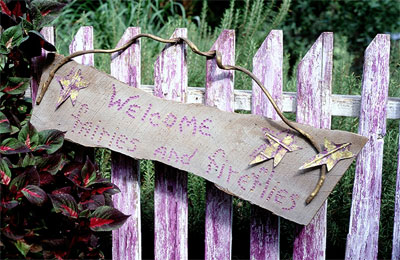From the Magazine: January/February 2014

A whimsical, handcrafted sign draws inspiration from the color palette, sense of humor and recycling interests of the garden’s owner.
by Diane Morey Sitton
Signposts
Handcrafted and recycled fun with garden signage
As if the language of flowers weren’t expressive enough, gardeners rely on signs to identify plants, relay messages, and impart inspiration. Like the flowers and foliage around them, the signs themselves impart ambience – especially one-of-a-kind handcrafted signs made from recycled materials.
From vintage tools to glass bottles to slate roof shingles, the immense array of salvageable materials sparks creativity. Techniques add flair to sign making, too. Get the message across by painting letters, or build embossed letters out of twigs.
Carve a poem into wood using a hand-held router, or fashion a message for the ages by affixing mosaic tile to a flat rock.
Signs of the times
Often, signs earn their keep by identifying herbs or vegetables in kitchen gardens. Placed near drifts of nectar-rich flowers, “Butterflies Welcome” identifies a butterfly zone and provides a perch for the ephemeral creatures. In gardens that twinkle with lights, “Fairies and fireflies welcome” increases the magic. Garden books, nature books, poetry collections and your own muse are sources for verses and quotes.
Signs with a re-purpose
Whether painted, engraved or embossed, lettering transforms reclaimed materials into message boards. For long-lasting hand-painted letters, use oil paint. Acrylic fades after a season or two.
Use the ideas below as a starting point for crafting your own garden marker.
• Recycle rusty weeding hoes, trowels and other discarded tools by applying plant names.
• Display cracked or chipped terra-cotta pots atop stakes. Small sizes work best. Use permanent markers to write the names of herbs and veggies on the pots.
• Salvaged slate roof shingles enhance silver gardens. Cut to size with a jigsaw blade. Drill two holes to accommodate a wire or cord hanger.
• Transform discarded fence pickets into upright markers. Paint white, add black lettering.
• Create a message on a bottle by painting plant names on red, green, blue or amber glass bottles. Suspend the bottles over stakes or steel rods.
• Cut scrap hardwood lumber to sign-size. Carve letters with a router. Paint the channels.
• Snip branches into short pieces to form block letters. Use tiny nails to configure the letters on a painted board.
• Affix cedar shakes to short wood stakes. Cedar complements garden plants.
• Arrange small pieces of tile, glass and broken china to form letters and a pattern on a flat rock or boulder. Complete the mosaic with grout.
Handcrafted signs made from recycled materials are expressive and decorative. Some are useful for identifying herbs, flowers and vegetables. Others capture the garden’s essence. What more could you ask for in a finishing touch?
Supplies:
The supply list for sign making varies, depending on the reclaimed materials and techniques selected. The list below includes items for basic projects.
• stencils (oilboard, plastic, etc.)
• oil paint and acrylic paint
• permanent markers
• craft paintbrushes
• screws, hooks, small nails, cord, wire
• tin (Create embellishments by cutting with tin snips.)
